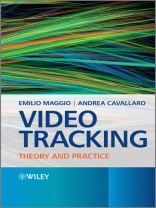Video Tracking provides a comprehensive treatment of the
fundamental aspects of algorithm and application development for
the task of estimating, over time, the position of objects of
interest seen through cameras. Starting from the general problem
definition and a review of existing and emerging video tracking
applications, the book discusses popular methods, such as those
based on correlation and gradient-descent. Using practical
examples, the reader is introduced to the advantages and
limitations of deterministic approaches, and is then guided toward
more advanced video tracking solutions, such as those based on the
Bayes’ recursive framework and on Random Finite Sets.
Key features:
* Discusses the design choices and implementation issues required
to turn the underlying mathematical models into a real-world
effective tracking systems.
* Provides block diagrams and simil-code implementation of the
algorithms.
* Reviews methods to evaluate the performance of video trackers
– this is identified as a major problem by end-users.
The book aims to help researchers and practitioners develop
techniques and solutions based on the potential of video tracking
applications. The design methodologies discussed throughout the
book provide guidelines for developers in the industry working on
vision-based applications. The book may also serve as a reference
for engineering and computer science graduate students involved in
vision, robotics, human-computer interaction, smart environments
and virtual reality programmes
Зміст
Foreword.
About the authors.
Preface.
Acknowledgments.
Notations.
Acronyms.
1 What is video tracking?
1.1 Introduction.
1.2 The design of a video tracker.
1.3 Problem formulation.
1.4 Interactive versus automated tracking.
1.5 Summary.
2 Applications.
2.1 Introduction.
2.2 Media production and augmented reality.
2.3 Medical applications and biological research.
2.4 Surveillance and business intelligence.
2.5 Robotics and unmanned vehicles.
2.6 Tele-collaboration and interactive gaming.
2.7 Art installations and performances.
2.8 Summary.
References.
3 Feature extraction.
3.1 Introduction.
3.2 From light to useful information.
3.3 Low-level features.
3.4 Mid-level features.
3.5 High-level features.
3.6 Summary.
References.
4 Target representation.
4.1 Introduction.
4.2 Shape representation.
4.3 Appearance representation.
4.4 Summary.
References
5 Localisation.
5.1 Introduction.
5.2 Single-hypothesis methods.
5.3 Multi-hypothesis methods.
5.4 Summary.
References.
6 Fusion.
6.1 Introduction.
6.2 Fusion strategies.
6.3 Feature fusion in a Particle Filter.
6.4 Summary.
References.
7 Multi-target management.
7.1 Introduction.
7.2 Measurement validation.
7.3 Data association.
7.4 Random Finite Sets for tracking.
7.5 Probabilistic Hypothesis Density filter.
7.6 The Particle PHD filter.
7.7 Summary.
References.
8 Context modeling.
8.1 Introduction.
8.2 Tracking with context modelling.
8.3 Birth and clutter intensity estimation.
8.4 Summary.
References.
9 Performance evaluation.
9.1 Introduction.
9.2 Analytical vs. empirical methods.
9.3 Ground truth.
9.4 Evaluation scores.
9.5 Comparing trackers.
9.6 Evaluation protocols.
9.7 Datasets.
9.8 Summary.
References.
Epilogue.
Further reading.
Appendix A: Comparative results.
A.1 Single versus structural histogram.
A.1.1 Experimental setup.
A.1.2 Discussion.
A.2 Localisation algorithms.
A.2.1 Experimental setup.
A.2.2 Discussion.
A.3 Multi-feature fusion.
A.3.1 Experimental setup.
A.3.2 Reliability scores.
A.3.3 Adaptive versus non-adaptive tracker.
A.3.4 Computational complexity.
A.4 PHD filter.
A.4.1 Experimental setup.
A.4.2 Discussion.
A.4.3 Failure modalities.
A.4.4 Computational cost.
A.5 Context modelling.
A.5.1 Experimental setup.
A.5.2 Discussion.
References.
Index.
Про автора
Dr Emilio Maggio, Vicon, UK
Dr Maggio is Computer Vision Scientist at Vicon, the motion
capture worldwide market leader. From 2004 – 2008 he was a
Ph.D. student at the Department of Electronic Engineering, Queen
Mary, University of London. In 2005 and again in 2007 he was
awarded the best student paper prize at ICASSP. Dr Maggio has acted
as a reviewer for the IEEE Transactions on Circuits and Systems for
Video Technology, the International Journal of Image and
Graphics and ACM Multimedia.
Dr Andrea Cavallaro, School of Electronic Engineering and
Computer Science, Queen Mary, University of London, UK
Dr Cavallaro is Reader in Multimedia Signal Processing at Queen
Mary, University of London. He is the author of more than 70
papers, including 5 book chapters. He is an elected member of the
IEEE Signal Processing Society, Multimedia Signal Processing
Committee. He has been a member of the organizing/ technical
committee for several international conferences such as Technical
Chair of EUSIPCO 08 and General Chair of the IEEE International
Conference on Advanced Video and Signal based Surveillance (AVSS
2007), with General Chair positions being held for forthcoming 2009
conferences such as BMVC 09. He has been guest editor of several
special issues, including ‘Multi-sensor object detection and
tracking’, Signal, Image and Video Processing (Springer). Dr
Cavallaro was awarded the Royal Academy of Engineering teaching
prize in 2007.












